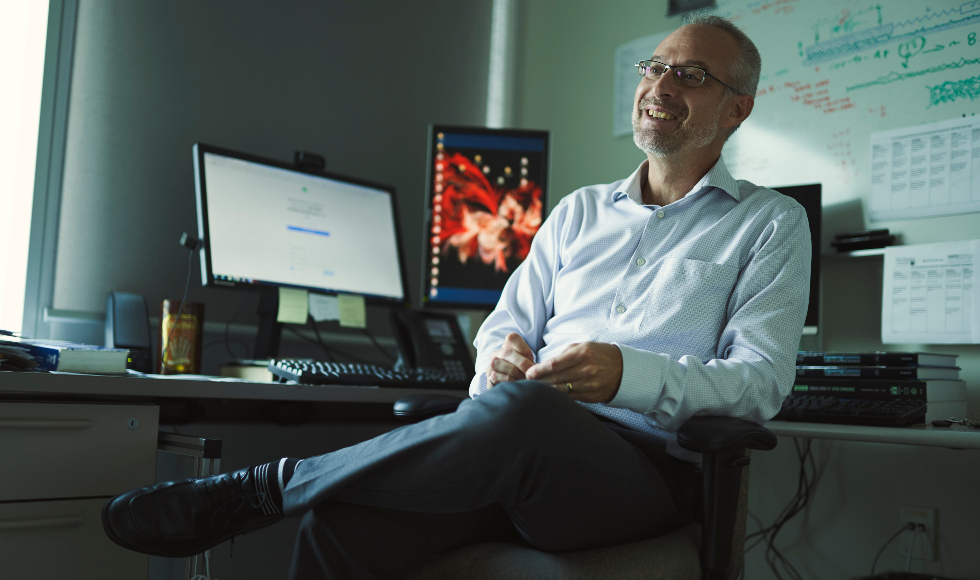Engineering Fresh Faces: Michael Justason

Photos by Jin Lee
BY Sara Laux
September 10, 2018
Welcome to Fresh Faces. In this series, we’re highlighting 43 Engineering faculty members, all hired in the last five years, who are doing interesting and innovative things in the lab and the classroom.
Michael Justason is the program chair of the Civil Engineering Infrastructure Technology program and chair of the Management courses in the W Booth School of Engineering Practice and Technology. Having worked in more than 40 countries over his 20-year career in industry, he now teaches classes in geotechnical and foundation engineering, engineering economics and communication for engineers.
On his research
I’m trying to develop a new physical model that explains earthquake ground motion based on the geometry of rocks.
I’m actually a PhD student, working with professors Tracy Becker and Dieter Stolle on earthquake engineering. I’m drawing ideas from many different areas of engineering – earthquake engineering, geotechnical engineering and fractal geometry – and putting it all together to develop a new physical model that explains earthquake ground motion. Essentially, it’s a theory of shaking.
Earthquake engineers use data from existing earthquakes as inputs for testing, and they also use synthetic ground motion, which is essentially a make-believe earthquake. The model I’m creating is a way to create make-believe earthquakes based on the geometry of nature, instead of random number generation.

On how he teaches
I like teaching – that’s why I’m here. I like it when I see that lightbulb go off over a student’s head and they understand something they didn’t understand before.
My industry experience has given me a lot of good stories from the outside world – so before a lecture, I try to think about stories or examples that can make the content personal, either for me or something that relates to the students. Humans remember things better when you can make a connection. You’d think it would be difficult to make a personal connection with things like math, but it is doable. After 20 years of working in the field, I can come up with examples of when you use a certain type of math on the job, or to avoid getting sued – people remember that, and it adds an element of importance.
I’ve created a series of lightboard teaching videos – it allows me to face the audience and work through a problem on the board at the same time. One of the most satisfying things for me is when students finish their final exams and tell me that they really liked the videos, or that the videos really helped them.
On the link between teaching and research
It’s fun, how it all fits together. A lot of what I’m doing in my PhD research is motivated by ideas that come from all different places, including from teaching. One of the key ideas that I’m using in my research is taken from a common lab test – we make this one little measurement just because it’s interesting, and I realized – hey, that’s interesting for other reasons.

If you’re a faculty member and you put a lot of effort into your teaching, you’d be surprised at what happens in your brain as a result, and that can be used in your research.
On the most influential person in his life
The person who influences me the most day-to-day is my wife. I’m the nerdy, introverted person and she’s the complete opposite. She studied sketch writing and improv at Second City in Toronto, and she teaches improv. She has her own company that does workshops that combine improv exercises and positive psychology. A lot of what she teaches I’ve actually used for my Communication for Engineers course.

On the assignment he calls “PowerPoint Karaoke”
I do an exercise called “PowerPoint Karaoke” to help students get over the fear of public speaking. Students have to give an impromptu two-minute presentation on a topic selected by the audience – and not only do they have to improvise for two minutes, but they also have to relate their talk to a series of random, unconnected PowerPoint images that I’ve put together.
So the audience may come up with the idea of talking about ninjas, and the first PowerPoint slide is of a car. The student has to think on their feet and figure out a way to relate the two.
Students hate the idea of having to do this, but once they’ve done it, they love it. If they get really stuck, the audience shouts out ideas, and that gets them going. The purpose is to show the speaker that the audience is (usually) friendly, and not to be afraid of making a mistake.
On what he’s watching on TV
I embarrassingly gravitate towards boring documentaries on Netflix – the latest thing I watched was a three-part series on geniuses of the modern world, which covered Karl Marx, Nietzsche and Freud.
I also really got into Game of Thrones, so when it came out on Netflix, I binge-watched – you couldn’t stop me. I have to make sure I have all my work done by the time the new episodes air in April.
On his dog
I have a miniature golden doodle – he comes into work with me sometimes.
He’s the perfect mix of a loyal family dog, like a retriever, and, like a poodle, he doesn’t shed. He rules our house – he manipulates everyone. If you give him a treat and he wants another one, he’ll go ask someone else, because he knows you won’t give him another one.

In the classroom…
I like to keep things entertaining, as much as possible.
Outside the classroom…
I probably spend too much time working! When I’m not prepping for my own courses or doing administrative stuff, I should be trying to study for my comprehensive exams.


